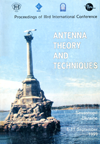Active integrated antenna amplifier for handset receiver front end
DOI:
https://doi.org/10.1109/ICATT.1999.1236268Abstract
Fast developments in the field of wireless mobile communications increase the demand for novel antennas and MMIC RF front end circuitry addressing the requirements of compactness, efficiency, and low cost. Recently, the active integrated antenna (AIA) approach became one of the most promising innovative designs in minimizing of interconnects and power consumption as well as increasing the efficiency of RF amplifiers [1-3]. Unlike the conventional configuration of receiver/transmitter front ends where the antenna and active circuit are separate components, their tight integration in AIA systems makes also possible the realization of broadband performance including efficient high-harmonics tuning [4]. Here we present a compact AIA receiver front end as a candidate for applications in the third-generation mobile communications handsets.
Size reduction becomes a key issue in designing antenna elements for integrated wireless handheld terminals, however the choice of dielectric rod helical antenna provides quite compact configuration of AIA amplifier. Because of direct integration of amplifier circuit and antenna in AIA approach, proper impedance matching proves to be a major condition for increasing the gain and minimizing the system's noise. The design and simulation of low-noise amplifier (LNA) for integrated receiver front end is presented and the measured results of AIA radiation pattern are demonstrated in this study.
References
Qian, Y.; Itoh, T. Progress in Active Integrated Antennas and Their Applications. IEEE Trans. Microwave Theory Tech., Nov. 1998, Vol. 46, p. 1891-1900.
Menzel, W. Low-Noise Active Receiving Antennas. Proc. of M+RF 97 Conf., 1997, London, UK. London, 1997, p. 83-88.
Hall, P.S.; Gardner, P.; Cryan, M.J.; Singh, D.; Kalialakis, C. Novel Integrated Active Antennas for Microwave and Millimeter Wave Applications. Proc. of M+RF 97 Conf., 1997, London, UK. London, 1997, p. 76-82.
Deal, W.R.; Radisic, V.; Qian, Y.; Itoh, T. Power Measurements for Push-Pull Integrated Antenna Power Combiner. Proc. of 1998 Asia-Pacific Conf., 1998, Yokohama, Japan. Yokohama, 1998, p. 703-706.

